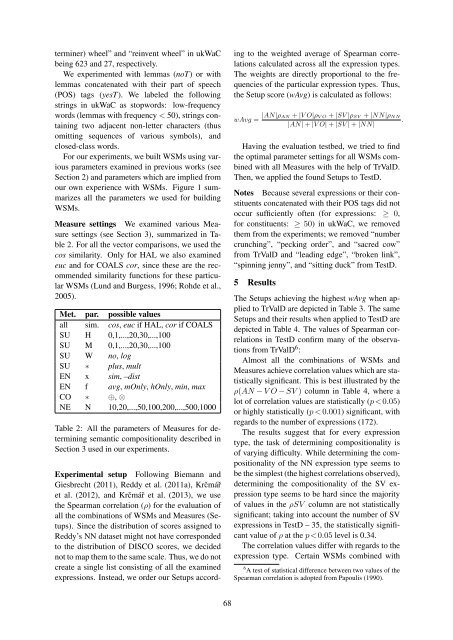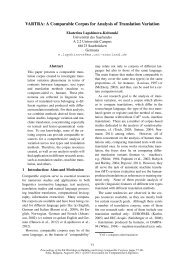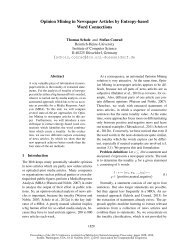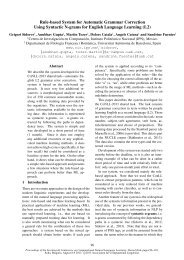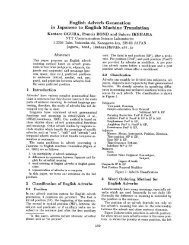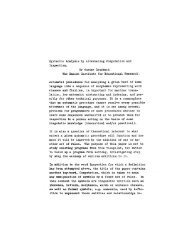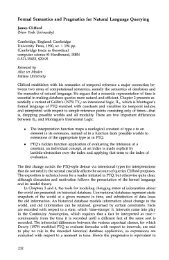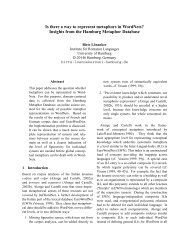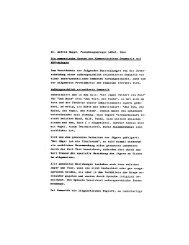Vector Space Semantic Parsing: A Framework for Compositional ...
Vector Space Semantic Parsing: A Framework for Compositional ...
Vector Space Semantic Parsing: A Framework for Compositional ...
You also want an ePaper? Increase the reach of your titles
YUMPU automatically turns print PDFs into web optimized ePapers that Google loves.
terminer) wheel” and “reinvent wheel” in ukWaC<br />
being 623 and 27, respectively.<br />
We experimented with lemmas (noT) or with<br />
lemmas concatenated with their part of speech<br />
(POS) tags (yesT). We labeled the following<br />
strings in ukWaC as stopwords: low-frequency<br />
words (lemmas with frequency < 50), strings containing<br />
two adjacent non-letter characters (thus<br />
omitting sequences of various symbols), and<br />
closed-class words.<br />
For our experiments, we built WSMs using various<br />
parameters examined in previous works (see<br />
Section 2) and parameters which are implied from<br />
our own experience with WSMs. Figure 1 summarizes<br />
all the parameters we used <strong>for</strong> building<br />
WSMs.<br />
Measure settings We examined various Measure<br />
settings (see Section 3), summarized in Table<br />
2. For all the vector comparisons, we used the<br />
cos similarity. Only <strong>for</strong> HAL we also examined<br />
euc and <strong>for</strong> COALS cor, since these are the recommended<br />
similarity functions <strong>for</strong> these particular<br />
WSMs (Lund and Burgess, 1996; Rohde et al.,<br />
2005).<br />
Met. par. possible values<br />
all sim. cos, euc if HAL, cor if COALS<br />
SU H 0,1,...,20,30,...,100<br />
SU M 0,1,...,20,30,...,100<br />
SU W no, log<br />
SU ∗ plus, mult<br />
EN x sim, –dist<br />
EN f avg, mOnly, hOnly, min, max<br />
CO ∗ ⊕, ⊗<br />
NE N 10,20,...,50,100,200,...,500,1000<br />
Table 2: All the parameters of Measures <strong>for</strong> determining<br />
semantic compositionality described in<br />
Section 3 used in our experiments.<br />
Experimental setup Following Biemann and<br />
Giesbrecht (2011), Reddy et al. (2011a), Krčmář<br />
et al. (2012), and Krčmář et al. (2013), we use<br />
the Spearman correlation (ρ) <strong>for</strong> the evaluation of<br />
all the combinations of WSMs and Measures (Setups).<br />
Since the distribution of scores assigned to<br />
Reddy’s NN dataset might not have corresponded<br />
to the distribution of DISCO scores, we decided<br />
not to map them to the same scale. Thus, we do not<br />
create a single list consisting of all the examined<br />
expressions. Instead, we order our Setups according<br />
to the weighted average of Spearman correlations<br />
calculated across all the expression types.<br />
The weights are directly proportional to the frequencies<br />
of the particular expression types. Thus,<br />
the Setup score (wAvg) is calculated as follows:<br />
wAvg =<br />
|AN|ρAN + |V O|ρV O + |SV |ρSV + |NN|ρNN<br />
.<br />
|AN| + |V O| + |SV | + |NN|<br />
Having the evaluation testbed, we tried to find<br />
the optimal parameter settings <strong>for</strong> all WSMs combined<br />
with all Measures with the help of TrValD.<br />
Then, we applied the found Setups to TestD.<br />
Notes Because several expressions or their constituents<br />
concatenated with their POS tags did not<br />
occur sufficiently often (<strong>for</strong> expressions: ≥ 0,<br />
<strong>for</strong> constituents: ≥ 50) in ukWaC, we removed<br />
them from the experiments; we removed “number<br />
crunching”, “pecking order”, and “sacred cow”<br />
from TrValD and “leading edge”, “broken link”,<br />
“spinning jenny”, and “sitting duck” from TestD.<br />
5 Results<br />
The Setups achieving the highest wAvg when applied<br />
to TrValD are depicted in Table 3. The same<br />
Setups and their results when applied to TestD are<br />
depicted in Table 4. The values of Spearman correlations<br />
in TestD confirm many of the observations<br />
from TrValD 6 :<br />
Almost all the combinations of WSMs and<br />
Measures achieve correlation values which are statistically<br />
significant. This is best illustrated by the<br />
ρ(AN − V O − SV ) column in Table 4, where a<br />
lot of correlation values are statistically (p


